How you can distinguish the siskin from the greenfinch and serin, how to identify a young siskin and how to support the native songbird in your own garden - you can find out all this in our species portrait.
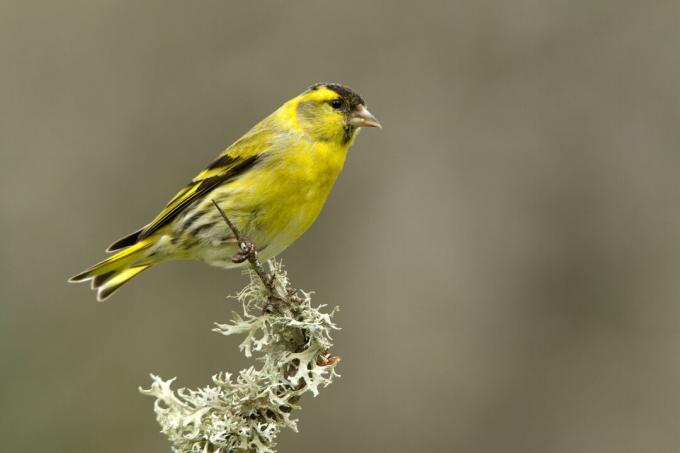
The Siskin (Carduelis spinus) is a somewhat rarer garden visitor. The colorful songbird mainly inhabits coniferous forests and is a fairly widespread breeding bird in Europe. It gets its name from its special fondness for alders and their seeds, which it can peck out of the cones with its narrow, pointed beak. Here you can find out how to clearly identify a siskin, how to distinguish it from other bird species and how you can support the songbirds in your own garden. Our profile offers you many lively pictures and exciting information about the siskin.
contents
- Siskin: wanted poster
-
How to recognize the Siskin
- How do siskin and greenfinch differ?
- How do siskin and serin differ?
- How do siskin females and males differ?
- How does the siskin song sound?
- What do Siskin eggs look like?
- How do you recognize a juvenile siskin?
- Which habitat does the siskin prefer?
- Where do siskins build their nest?
- When is the Redpoll breeding season?
- Where does the siskin spend the winter?
-
Supporting the siskin in the garden: Here's how
- What do siskins eat?
- Which nesting aids are suitable for siskins?
- How can you give additional support to the siskin?
Siskin: wanted poster
| size | about 12cm |
| Weight | 12-16g |
| breeding season | April - July |
| lifespan | about 5 years |
| habitat | Coniferous forests, parks and gardens with coniferous trees |
| feed preference | tree seeds, nuts and insects |
| threats | decline in food and habitat |
How to recognize the Siskin
Siskins are quite small, delicate songbirds. Their back is olive green in colour, while the elytra and tail are quite dark, with strong and contrasting yellow bands running through them. In flight, the lower back, also known as the rump, can also be seen, which is also colored yellow. The belly of the siskin, on the other hand, is white and has strong black stripes, which are particularly easy to see from the front.

How do siskin and greenfinch differ?
One can confuse the siskin with the greenfinch, for example, which has a similar color spectrum. However, siskins are much smaller and have a less powerful beak. They are also distinguished by the almost black wing and tail feathers and the strong yellow elements - the greenfinch has a more washed-out, gray-green color.
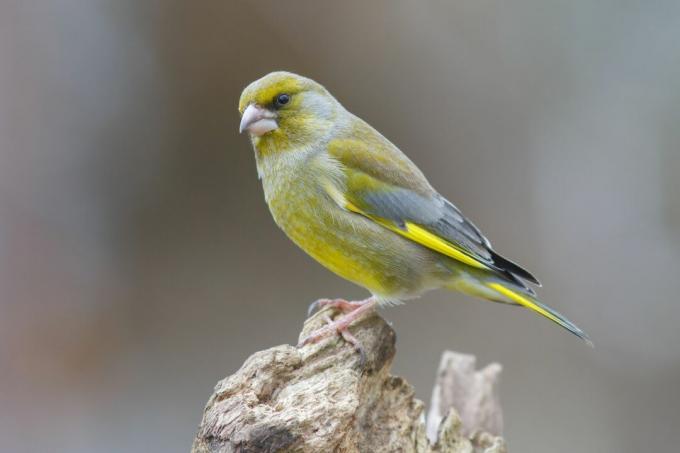
How do siskin and serin differ?
The risk of confusion with the greenfinch is even higher than with the greenfinch Serin. This one also has dark plumage, a yellow rump and a dark dashed belly. However, the serin can be distinguished by its yellow forehead, the dark, olive-colored cheek area and the narrower, yellow wing bars.
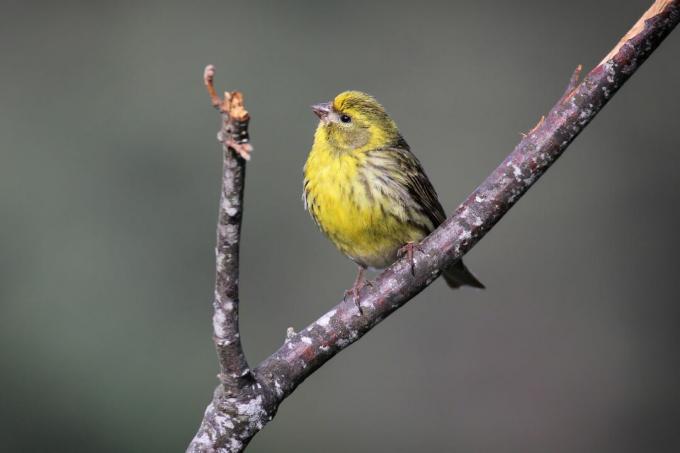
How do siskin females and males differ?
As with many bird species, the male siskin is slightly flashier and more colorful than his mate. He has a bright yellow chest and matching sides of head that contrast with his jet black forehead and matching throat patch. The females, on the other hand, are grey-green in the head area and their chest only has a yellowish tinge before it merges into the white belly plumage.

How does the siskin song sound?
The song of the siskin consists of a stanza of clear whistles, which is mixed with trills and sometimes squeaky sounds. The song can also contain imitations of other bird species, which makes identification not always easy. Furthermore, the siskin also has several calls that are just as clear and high-pitched as the whistling tones of its song.
You can find out how the siskin song sounds here:
What do Siskin eggs look like?
Siskin females lay between two and six eggs per clutch. These are about 1.6 cm tall and can vary slightly in color. Some scrims are white, others gray and others even have a slightly blue base color. As a rule, however, they are all covered with small, delicate brown spots.
How do you recognize a juvenile siskin?
Young siskins are still somewhat inconspicuous. They are similar to the females in terms of coloring, but are even simpler. Their back is grey-brown, the underside is plain white and the plumage is streaked with fine dark stripes. The green and yellow color elements of the adult animals only develop later. However, the fact that the young birds are siskins can already be seen from the black elements on the elytra and tail feathers. This is how they differentiate themselves from young greenfinches, for example.
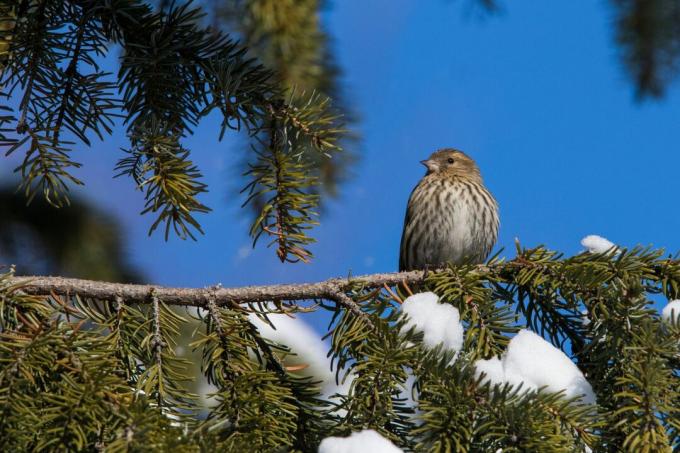
Which habitat does the siskin prefer?
Siskins prefer coniferous and mixed forests. But they can also feel at home in parks and gardens if they find inviting stands of conifers. Siskins are widespread and their occurrence in Europe is strongly based on the supply of conifers. Even at slightly higher altitudes they feel comfortable.
Where do siskins build their nest?
Siskins build their nests in tall conifers – preferably in bushy spruces. The nest is hidden in high branches and built there from twigs, grass and moss. The nest hollow in which the eggs are laid is padded with soft down feathers.
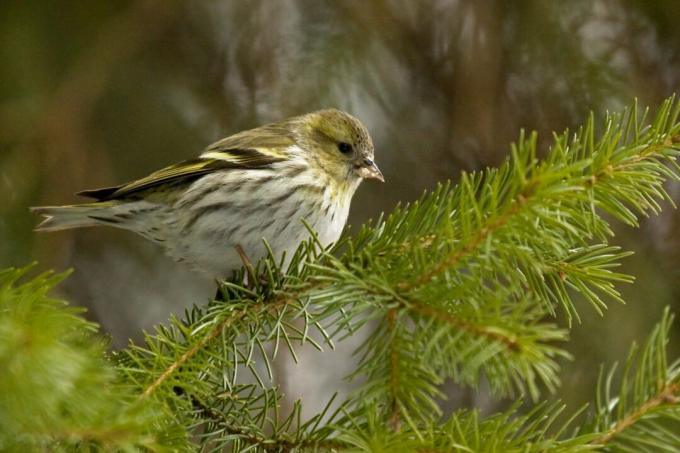
When is the Redpoll breeding season?
Siskin pairs are usually found as early as the winter months - long before the breeding season begins. This exciting time starts in April, when the first eggs are laid. The clutch is incubated for about 13 days before the young hatch. These are then fed for a further 15 days in the nest before they start exploring. After that, however, the young remain close to the nest and receive support from their parents for a few more weeks before they have to fend for themselves. Siskins breed in smaller colonies of up to six breeding pairs and often start a second brood around June.
Where does the siskin spend the winter?
The polka dot stays with us even during the cold winter months. During this time, the small breeding colonies form sometimes large swarms that move across the fields together in search of food. These flocks are often joined by other winter birds, for example goldfinches or Redpoll. If you go for a walk in winter, you can often see large groups flying up in front of you.
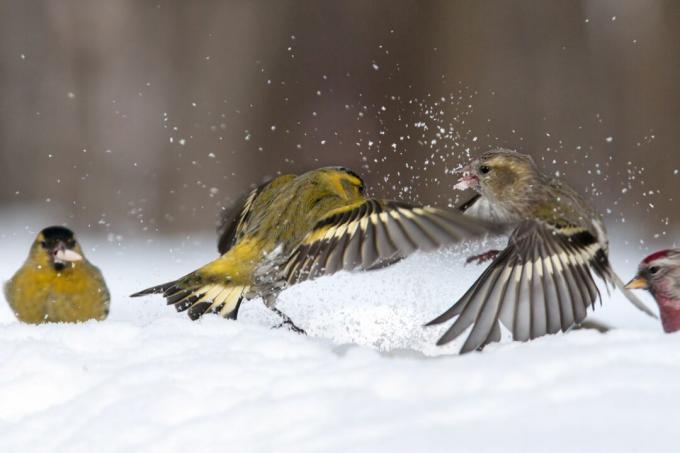
Supporting the siskin in the garden: Here's how
Depending on the region, siskins are almost a rarity among garden birds. It is all the nicer when you can actually observe one of the yellow-black birds in your home. Here you can find out how you can lure the siskin into your garden and support it in its daily struggle for food and nesting sites.
What do siskins eat?
Siskins feed mainly on tree seeds, such as birch or alder. However, they also use other seed-bearing plants such as thistles, sorrels or meadowsweet. They also eat insects picked from trees and plants during the breeding season. This protein-rich diet is particularly important for rearing young birds.
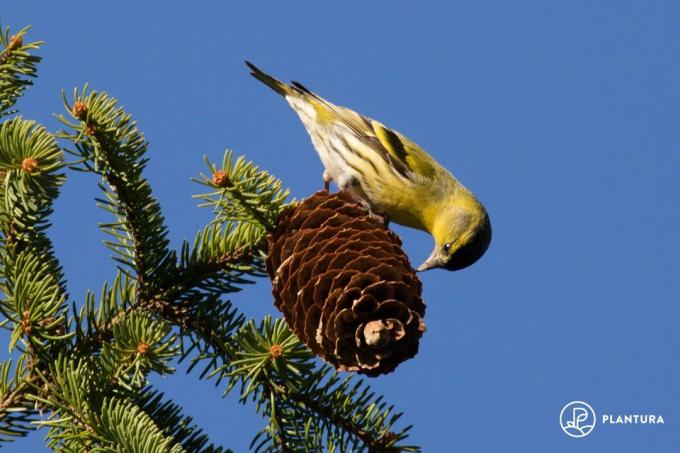
Siskins also come into gardens and bird feeders, especially in winter. There they pick fine seeds from loose and grain feed and also help themselves to fat feed cakes and suet balls. So if you want to offer the little songbirds a special treat, try ours Plantura fat balls. These consist of high-quality insect fat and rich nuts, seeds and berries. They also do completely without plastic nets, which produce unnecessary waste and in which the birds could get tangled and injure themselves.

Plantura fat balls
Sustainable fat balls without a net,
Species-appropriate wild bird food with insect fat for year-round feeding
Which nesting aids are suitable for siskins?
Classic nesting boxes as they are made for blue tits or starlings are not suitable for siskins, as these are free breeders and set up their nests freestanding in trees. However, if you can serve with coniferous trees - preferably spruce - in your garden, you have a chance of a siskin in your own green. In this case, however, be careful not to thin out or cut back the trees too much, as the songbirds build their nests in the shelter of the dense branches.
How can you give additional support to the siskin?
In addition to offering birdseed, you can also help the siskin in other ways in its search for food. With seed-bearing perennials and wild herbs, such as thistles or meadowsweet, you can create a natural source of food. And during the breeding season, a insect friendly garden for the necessary protein requirements of the young birds.
On hot summer days you can also make life easier for the siskin by having a water point in the garden. A pond, a stream or a simple bowl of water can be of great help during this time and attract numerous small visitors. However, make sure to clean your water point regularly. Especially at high temperatures, bird baths and baths can quickly develop into breeding grounds and sources of infection for bird diseases and should therefore be cleaned daily.

Another garden visitor who spends the cold winter months with us and likes to hang around in conifers is the coal tit. You can also get to know this native songbird in our species portrait.
...and receive concentrated plant knowledge and inspiration directly in your e-mail inbox every Sunday!



